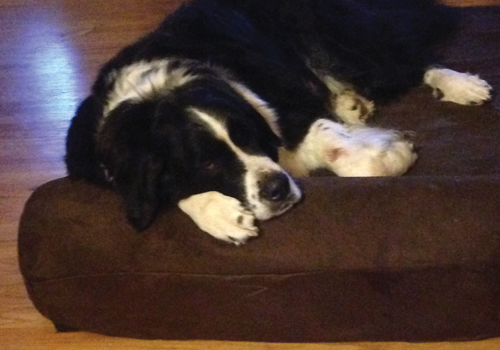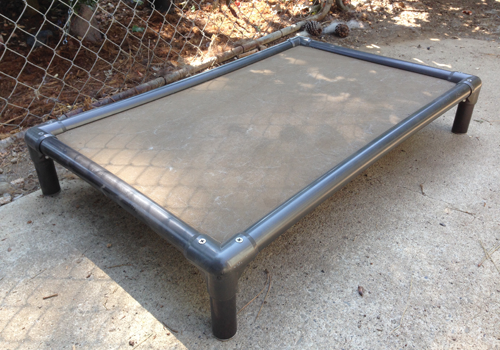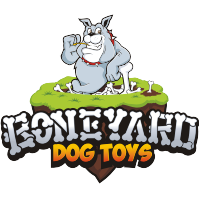Crates and beds come in every shape and size to match your dog
Your dog will want his own space. A space he can call his own may be a place to seek refuge amidst chaos or just a place to crash that's off the beaten path. Training your dog to recognize their place is a simple obedience task and the use of toys can make the task easier. For tips on how to get your dog accustomed to using a crate and the place command, see our crate training discussion. The current page discusses the various options for creating their home space, a place they will consider their very own sanctuary.

Examples of the two primary types of crates
There are primarily two styles of crates. There are folding wire crates and plastic shell
crates. Both styles come in sizes to fit the smallest dogs up to the giant breeds and both achieve the goal of securing your dog in a safe enclosure.
Location is also a consideration. Ideally, the crate should be where the family spends most of its time. Keep in mind that if the crate is in a drafty location or a spot that gets full sun, your dog will not be able to move if this causes distress.
Before deciding on a location for the crate, pay attention to where your dog chooses to lay down. Some dogs prefer to be right in the middle of everything while others want to be off to the side within view of what's going on. Understanding their preference will help locate the crate in a spot they will feel comfortable with.
Choosing between a folding wire crate and a plastic crate
For some, which type of crate to buy is entirely a personal preference. But to help with the decision process, here are a few points to consider when deciding whether to go with a wire crate or a plastic crate.
Pros and cons of wire crates
For some, the ability to fold up the crate for traveling or storing is a big convenience. However, determine how the crate folds up because many of the older wire crates had to be broken down by removing a rod at each corner. The newer wire crates are designed to be folded more easily without dismantling them. The newer crates are available with either one or two doors. A second door oftens comes in handy.
Wire crates are designed with a tray in the bottom that can be slid out for easy cleaning. The top and sides of wire crates are not easily soiled so they rarely require cleaning.
The open nature of wire crates makes them ideal for warmer conditions. If adequate ventilation is a consideration, then a wire crate may be more suitable. In other words, this style of crate may be less desirable in drafty or colder conditions.
Pros and cons of plastic crates
For dogs that are not used to riding in a car, the plastic crate can be very convenient for traveling. Especially if your dog is new to being in a car and prone to getting car sick.
The plastic crate affords greater enclosure and therefore has more of a den like feel. For many of the plastic crates, temporarily removing the door is easy and makes the crate appear less forboding.
Because the plastic crate is more enclosed, its ideal for conditions where it gets cold at night.
When considering this type of crate, look for a style that has a large door opening, plenty of ventilation holes around the sides, easily comes apart and a molded floor that does not have bumps and ridges. Your dog needs to be comfortable laying inside even when a mat or bed are used.
Selecting the right size crate
Choosing the proper size is essential if your crate is going to work. The rule of thumb is that your dog must be able to stand up and easily turn around with a little bit of room to spare.
If the crate is too large, it loses its effectiveness as a cozy den. It also makes it possible for your dog to relieve himself at one end and sleep at the other end. Dog's will generally not sleep in bedding they have soiled. It generally is the case, if your dog is making a mess in his crate, the crate may be too large. Reduce the size slightly according to the rule of thumb mentioned above and be sure your dog goes outside for a bathroom break before being placed in the crate.
If the crate is too small, then your dog will be cramped and uncomfortable and ultimately grow to resent being placed in the crate.
Before purchasing your dog's crate, spend some time observing how they curl up on their bed. This will give you an idea as to how they sleep.
Video dipicts properly sized crate
Choosing the right bedding
Its good to have a spot your dog knows is just for him. This spot can be as simple as a pillow or blanket or as ellaborate as an elevated bed with a pad. The goal is to get your dog to understand it is his space, a place to crash and relax. If he makes the association with a specific blanket, pad, pillow, bed or whatever this is a golden opportunity for you. Now, where ever you place his bed, he knows that is where he is to sleep.

Young dog knows his place on a pad
Foam pads and stuffed beds
Foam and pillow are the most common sleeping arrangements made for most dogs. They come in all sizes and materials. When thinking about what to purchase, there are several considerations.
First, look for bedding that can be easily cleaned. Dog beds absorb odors and get soiled so it needs to be washable. For the small dog beds, this can mean the whole bed goes in the wash. For larger beds, the cover should unzip and ideally there is a water proof cover underneath that can also be removed.
Having a simple pad comes in handy in a number of situations. A bolster pad can be used around the house, especially if your dog is place trained. They also come in a wide range of sizes designed to fit in the bottom of most crates. They are easily washed which is also a big bonus.
The second primary consideration is matching the bed to the weight of your dog. For small to medium sized dogs, this is less of a problem. For smaller dogs, weight is not the issue so the polyfill beds are nice and the whole bed can be thrown in the washer. For the medium sized dogs, the memory foam
pads are adequate to support their weight. The removable cover makes clean up easy. The issue of support becomes very important for breeds that exceed 60-80 pounds. These are also the breeds that are more prone to joint disorders as they age.
Beds for larger dogs need to offer support that doesn't break down in a short amount of time. This is particularly true with most thin foam pad beds, the foam pads that are 2 - 3 inches thick. Even many of the more expensive memory foam beds are not designed to prevent pressure points that occur at elbow and hip joints when a dog lies in any number of positions.
There are a number of orthopedic pads now available for the larger breeds. This is another area where its important to be aware of where the material for the bed is sourced. Much of the memory foam manufactured in China is not of the same quality as that manufactured in the USA. Check out the larger bolster and mat
beds by Mammoth Dog Beds or the Big Barker Orthopedic
beds that focus more on large breed dogs. These beds hold up over time and prevent pressure point issues for large breeds. These beds feature removable covers for washing.

Large dog sleeping peacefully on a Big Barker bed
The orthopedic pads by Big Barker are premium beds with the idea of minimizing pressure points for the way dogs lay on a bed. Also, the foam construction is designed to withstand years of heavy use. Sold separately is an inner waterproof liner that makes cleaning up convenient, keeping the pad clean and fresh smelling. In the heat of the summer the pads can get a little warm at which point its time to switch to an elevated bed.
Elevated beds
Orthopedic support is at the heart of the elevated bed concept. These beds are designed to minimize pressure points through distributed support of the dog's weight and eliminate contact with the floor.
There are a number of brands on the market and they differ in several important respects. Popular brands of elevated beds include the Coolaroo and the Kuranda, but more recently others have entered the market such as PetCot, and the Cujo Cot by K9 Ballistics.

The Kuranda elevated bed
A significant differentiator among the various brands is whether or not the bed is chew proof. For many dogs this is not a problem. But for others, the desire to chew at the open edge of fabric in each corner is irresistable. As a result, there are two distinctly different designs on the market.

Chewed edge of bed
The Original Elevated Pet Bed By Coolaroo and beds of similar design, wrap the fabric around the tubular frame. The fabric along each side stops short of the corner and the result is a triangular gap between the fabric and the tubing at each corner. Unfortunately, the edge of the fabric becomes a target for chewing. The PetCot elevated bed has the same limitations, however attempts a solution to the exposed fabric in the corner by designing a plastic corner piece, the "chew guard", that hides the edge of the fabric.
The elevated cots by Furhaven Pet Products have a minimal amount of exposed fabric in the corners but many of the customers complain about the seems ripping out in a short amount of time.
The Kuranda bed and other similar "chew proof" designs like the Cujo Cots
by K9 Ballistics hide the edge of the fabric along its entire length inside a channel in the tubing. This prevents the fabric edge from being chewed on.
The remaining differences are largely related to the materials used for the frame and the fabric. The frames are either made of a PVC or aluminum material. For dogs in excess of 125 pounds its best to go with an aluminum frame. The fabrics are a rip stop synthetic material. Depending on the tightness of the weave these will be more or less water proof and breathable.
Kuranda beds of different sizes
In order to fit your dog to the right size bed, get an approximate measure of the floor space they occupy when laying down. The above video depicts several different styles and sizes of Kuranda beds. The two smaller beds are both the large size beds, the first with Birch Forest Vinyl Weave, ideal for outdoor use and the second large bed shows the Heavy Duty Vinyl in Smoke
which is ideal for our household that constantly sees new foster dogs. Finally the XXL PVC bed in Heavy Duty Vinyl and Forest Green
is for our large breeds. But, if your dog is well above 125 pounds, it may be best to go with the Kuranda All-Aluminum Bed.
For comparison, the other "chew proof" design includes the large and XX-Large
Cujo Cots by K9 Ballistics. The fabric used is a proprietary rip-stop fabric and the frames are all made of aluminum. Otherwise, both brands get high marks.
Sign up for our FREE report.
"What Trainers Say About Using Toys During Training"

To receive a digital copy of our 15-page report, click on the eReport image above. The book covers some interesting applications of toys used by dog trainers to reinforce behaviors.
Your email address is totally secure and will only be used to send you the report.

